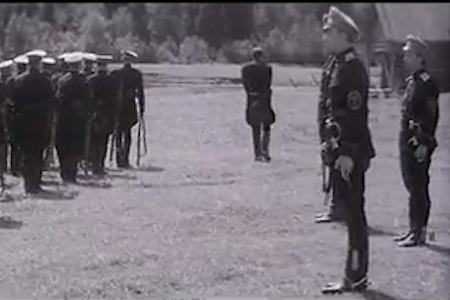The Red and the White Shot #70
From what I can tell, this shot from Miklós Jancsó‘s The Red and the White (1968) was filmed with the camera mounted on a single dolly track that allowed it to move smoothly back and forth across several feet. By combining different degrees of zooms at different positions along the dolly track, the scene yields a stunning variety of shots. The camerawork has a pendulum-like quality. Not only does it move left and right along the dolly, it also zooms forward and backward, alternating between close-ups that capture the intimate expressions of a face, or exchanges between two people, and wide panoramic shots of soldiers and prisoners in formation. While the camera rests at certain points, it is never stable, conveying a sense of anxious uncertainty in wartime.
This one shot features over 100 actors, and the choreography of their bodies creates different geometries and patterns from start to finish. Notice how this shot is the same as one at the beginning, except now a group of prisoners are lying where it was once an open field of grass. It attests to the clockwork choreography of the scene. All of this culminates in a brilliant moment, this amazing deep focus shot of the White Army soldiers spotting Red Army horses across the river, and the White Army captain is then killed by a shot from an offscreen source. The horses were a decoy for the Red rebels to launch their attack from the opposite direction. It’s a scene whose timing is full of irony—if the rebels had arrived earlier, they could have stopped the executions, but they had to wait for the White platoon to leave, ironically in search of the rebels. The choreography of the scene is symbolic, representing the conflict between the order imposed by the oppressive White Army and revolutionary chaos of the Red soldiers. Here, the victory is a conquest of cinematic space.
Video: ‘Mapping the Long Take’
The Turin Horse Shot #22
Comparing this one shot from The Turin Horse (2011) with the one that we just watched, you can see how Bela Tarr‘s use of the long take both incorporates and rejects different elements of Jancso’s camerawork. Here the camera is less active and elaborate, and the staging is less busy. Instead, there’s a greater emphasis on physicality. The wind and the leaves blowing across the frame, the way the camera tracks along closely with the woman as she hauls the wagon, focusing on her exertion. The moments where the camera is static let us focus on the material, tactile qualities of the visuals: stone, wood and dirt. The camera follows the man with a sweeping lateral motion. The low angle conveys a perspective of reverence towards this figure.
Miklos Jancso uses the real-time long take to create an abstract spectacle of human cruelty as a function of time and space. Bela Tarr uses it to convey the palpable sensations of a lived experience, one of harsh, grueling exertion. Like the Jancso scene, there’s a pendulum-like rhythm to the camera movement as it moves back and both between two poles of activity. Like Jancso, though to a lesser degree, Tarr is able to use off-screen space to economize activity: Notice how by the time the camera returns to the house, the woman has almost finished packing the wagon.
All of this is done with a handheld camera, which gives it a slightly unstable quality, in contrast to the precision of Jansco’s dolly-mounted camera. Again, the emphasis is on human effort. Here, each footstep has a felt impact. There’s a greater sensitivity to the textures, of the many layers of clothing heaped on the woman, how they stretch and rustle with each stride forward. There’s a paradoxical sense of life moving forward, yet everything stays the same. Everything on screen has a fundamental immutable essence, moving and staying still.
Kevin B. Lee is Editor in Chief of IndieWire’s PressPlay Video Blog, Video Essayist for Fandor’s Keyframe, and a contributor to Roger Ebert.com. Follow him on Twitter.




